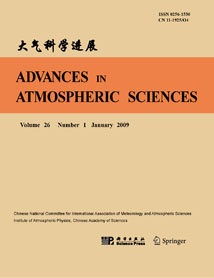| [1] |
Xun Zhu,
1988: A STEADY TWO-DIMENSIONAL CLIMATE MODEL WITH RESIDUAL CIRCULATION, ADVANCES IN ATMOSPHERIC SCIENCES, 5, 455-468.
doi: 10.1007/BF02656791
|
| [2] |
Zhang Renjian, Wang Mingxing, Zeng Qingcun,
2000: Global Two-Dimensional Chemistry Model and Simulation of Atmospheric Chemical Composition, ADVANCES IN ATMOSPHERIC SCIENCES, 17, 72-82.
doi: 10.1007/s00376-000-0044-3
|
| [3] |
Xu Yongfu, Wang Mingxing,
1998: A Two-Dimensional Zonally Averaged Ocean Carbon Cycle Model, ADVANCES IN ATMOSPHERIC SCIENCES, 15, 370-379.
doi: 10.1007/s00376-998-0007-7
|
| [4] |
Yongkang Xue,
1991: A Two-Dimensional Coupled Biosphere-Atmosphere Model and Its Application, ADVANCES IN ATMOSPHERIC SCIENCES, 8, 447-458.
doi: 10.1007/BF02919267
|
| [5] |
Sun Litan, Huang Meiyuan,
1994: Improving the Vorticity-Streamfunction Method to Solve Two-Dimensional Anelastic and Nonhydrostatic Model, ADVANCES IN ATMOSPHERIC SCIENCES, 11, 247-249.
doi: 10.1007/BF02666551
|
| [6] |
Mozheng Wei,
1996: A Low-order Model of Two-dimensional Fluid Dynamics on the Surface of a Sphere, ADVANCES IN ATMOSPHERIC SCIENCES, 13, 67-90.
doi: 10.1007/BF02657029
|
| [7] |
Hu Yinqiao, Su Congxian, Ge Zhengmo,
1988: A TWO-DIMENSIONAL AND STEADY-STATE NUMERICAL MODEL OF THE PLANETARY BOUNDARY LAYER, ADVANCES IN ATMOSPHERIC SCIENCES, 5, 523-534.
doi: 10.1007/BF02656796
|
| [8] |
Yang Hongwei, Wang Bin, Ji Zhongzhen,
2002: Application of the Artificial Compression Method to the Simulation of Two-Dimensional Frontogenesis, ADVANCES IN ATMOSPHERIC SCIENCES, 19, 863-869.
doi: 10.1007/s00376-002-0051-7
|
| [9] |
S. Panchev,
1990: An Exact Solution for Two-Dimensional Frictionless Motion in the Atmosphere, ADVANCES IN ATMOSPHERIC SCIENCES, 7, 137-141.
doi: 10.1007/BF02919151
|
| [10] |
Lei WANG, Qing BAO, Wei-Chyung WANG, Yimin LIU, Guo-Xiong WU, Linjiong ZHOU, Jiandong LI, Hua GONG, Guokui NIAN, Jinxiao LI, Xiaocong WANG, Bian HE,
2019: LASG Global AGCM with a Two-moment Cloud Microphysics Scheme: Energy Balance and Cloud Radiative Forcing Characteristics, ADVANCES IN ATMOSPHERIC SCIENCES, , 697-710.
doi: 10.1007/s00376-019-8196-9
|
| [11] |
Ken-ichi SHIMOSE, Ming XUE, Robert D. PALMER, Jidong GAO, Boon Leng CHEONG, David J. BODINE,
2013: Two-Dimensional Variational Analysis of Near-Surface Moisture from Simulated Radar Refractivity-Related Phase Change Observations, ADVANCES IN ATMOSPHERIC SCIENCES, 30, 291-305.
doi: 10.1007/s00376-012-2087-7
|
| [12] |
YUE Caijun, SHOU Shaowen, Xiaofan LI,
2009: Water Vapor, Cloud, and Surface Rainfall Budgets Associated with the Landfall of Typhoon Krosa (2007): A Two-Dimensional Cloud-Resolving Modeling Study, ADVANCES IN ATMOSPHERIC SCIENCES, 26, 1198-1208.
doi: 10.1007/s00376-009-8135-2
|
| [13] |
LI Xiaofan, SHEN Xinyong, LIU Jia,
2014: Effects of Doubled Carbon Dioxide on Rainfall Responses to Large-Scale Forcing: A Two-Dimensional Cloud-Resolving Modeling Study, ADVANCES IN ATMOSPHERIC SCIENCES, 31, 525-531.
doi: 10.1007/s00376-013-3030-2
|
| [14] |
Shou Shaowen, Li Shenshen,
1991: Diagnosis of Kinetic Energy Balance of a Decaying Onland Typhoon, ADVANCES IN ATMOSPHERIC SCIENCES, 8, 479-488.
doi: 10.1007/BF02919270
|
| [15] |
Xinrong WU, Shaoqing ZHANG, Zhengyu LIU,
2016: Implementation of a One-Dimensional Enthalpy Sea-Ice Model in a Simple Pycnocline Prediction Model for Sea-Ice Data Assimilation Studies, ADVANCES IN ATMOSPHERIC SCIENCES, 33, 193-207.
doi: 10.1007/s00376-015-5099-2
|
| [16] |
Ji jinjun,
1989: Atmosphere-Ocean Coupling Schemes in a One-Dimensional Climate Model, ADVANCES IN ATMOSPHERIC SCIENCES, 6, 275-288.
doi: 10.1007/BF02661534
|
| [17] |
WANG Linlin, GAO Zhiqiu, MIAO Shiguang, GUO Xiaofeng, SUN Ting, Maofeng LIU, Dan LI,
2015: Contrasting Characteristics of the Surface Energy Balance between the Urban and Rural Areas of Beijing, ADVANCES IN ATMOSPHERIC SCIENCES, 32, 505-514.
doi: 10.1007/s00376-014-3222-4
|
| [18] |
Minwei Qian, N. Loglisci, C. Cassardo, A. Longhetto, C. Giraud,
2001: Energy and Water Balance at Soil-Air Interface in a Sahelian Region, ADVANCES IN ATMOSPHERIC SCIENCES, 18, 897-909.
|
| [19] |
SUN Shufen, ZHANG Xia,
2004: Effect of the Lower Boundary Position of the Fourier Equation on the Soil Energy Balance, ADVANCES IN ATMOSPHERIC SCIENCES, 21, 868-878.
doi: 10.1007/BF02915589
|
| [20] |
WANG Runyuan, ZHANG Qiang,
2011: An Assessment of Storage Terms in the Surface Energy Balance of a Subalpine Meadow in Northwest China, ADVANCES IN ATMOSPHERIC SCIENCES, 28, 691-698.
doi: 10.1007/s00376-010-9152-x
|















 AAS Website
AAS Website 
 AAS WeChat
AAS WeChat 
 DownLoad:
DownLoad: